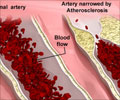According to a study, screening for high cardiovascular disease risk should be based on individual risk level.

‘Cardiovascular disease prevention through lifestyle intervention or preventive medication could be enabled more effective through individualized screening interval.’





If lifestyle interventions are inadequate to reduce the risk, the guidelines recommend primary preventive medication such as statins. However, the 5-yearly screenings are not based on direct research evidence. "Our study shows that by optimizing the screening intervals, 8% of myocardial infarcts and strokes could be prevented without increase in health care costs. This means that during the next 20 years, in the English population aged now 40 to 64, the number of new myocardial infarcts or strokes prevented annually could reach 5000," says lead author Joni Lindbohm MD, PhD from the University of Helsinki.
The authors estimated the optimal screening interval by following development of cardiovascular disease risk in 7000 English men and women who participated in the Whitehall II study. This study measured their cardiovascular disease risk factors according to the current guidelines in 5-yearly intervals over a 22-year follow-up and collected data on cardiovascular diseases using national electronic health and death records.
Those at low risk for cardiovascular diseases spent on average 9 years in that risk category before moving to intermediate-low risk. The participants then spent on average 7 years in this next category before progressing to intermediate-high risk. However, the time spent in intermediate-high risk was only 4 years; after this, over 70% of participants progressed to the high-risk category that leads to consideration of preventive medication if lifestyle intervention is insufficient to reduce the risk.
An individualized screening interval would enable more effective cardiovascular disease prevention by means of lifestyle intervention or preventive medication, because of more timely detection of those at high risk.
Advertisement
Advertisement











